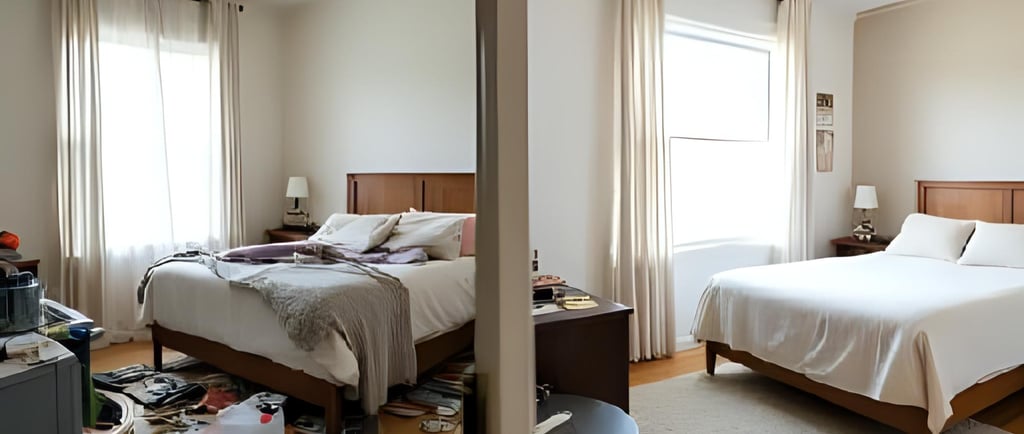Decluttering Tips That Actually Work: A Room-by-Room Guide
Stop feeling overwhelmed by clutter. This step-by-step decluttering guide makes it manageable with proven strategies for every room. Real methods that create lasting results.
10/12/20256 min read


I lived in clutter for years. Every surface was covered, closets overflowed, and I felt constantly overwhelmed. I tried organizing, but within days everything was a mess again.
Then I learned the truth: you can't organize clutter. You have to declutter first, then organize what's left.
These decluttering strategies transformed my home from chaotic to calm. They work because they're based on psychology, not just willpower.
Here's the exact process I use, room by room.
Want my free Ultimate Home Organization Checklist? Click the "Get Started" button at the bottom to get instant access!
Why Decluttering Fails (And How to Fix It)
Common decluttering mistakes:
Starting with the hardest room (sentimental items)
Trying to declutter your entire house in one day
Not having a plan for items you're getting rid of
Organizing before decluttering
Keeping things "just in case"
What actually works:
Start small with quick wins
Follow a proven decision-making system
Have donation bags ready before you start
Declutter first, organize second
Use the "one-year rule"
The Core Decluttering Principles
Principle #1: If You Haven't Used It in a Year, You Won't
Be honest. That bread maker, those jeans that might fit again, the craft supplies for a project you'll "get to someday"—if it's been a year, it's not happening.
Exception: Seasonal items and sentimental keepsakes (but be selective).
Principle #2: One In, One Out
Buy something new? Donate something old. This prevents clutter from accumulating again.
Principle #3: Everything Needs a Designated Home
If an item doesn't have a specific place, you don't have room for it. Get rid of it or create space.
Principle #4: Visible Storage Only
If you can't see it, you'll forget you have it and buy duplicates. Clear containers and open storage are your friends.
Principle #5: The 20/20 Rule
If you can replace it in 20 minutes for under $20, don't keep it "just in case." Get rid of it. You can replace it if needed (you probably won't need to).
The Decluttering Decision Framework
For every item, ask these questions in order:
1. Do I use this regularly?
Yes → Keep it
No → Next question
2. Do I love this?
Yes → Keep it
No → Next question
3. Would I buy this again today?
Yes → Keep it
No → Next question
4. Does this serve a specific purpose I can't fulfill another way?
Yes → Keep it
No → Get rid of it
Still unsure? Put it in a "maybe box." Store it for 3 months. If you don't need it, donate it.
Room-by-Room Decluttering Guide
Start Here: The Easiest Wins
Don't start with sentimental items or your worst room. Start where you'll see fast results.
Best rooms to start:
Bathroom (easiest, quick wins)
Kitchen junk drawer (fast transformation)
Entryway/coat closet (high impact, low emotion)
Bathroom Decluttering (30-45 minutes)
Declutter these immediately:
Expired medications and skincare
Dried-up makeup and nail polish
Hotel toiletries you'll never use
Products you bought and didn't like
Duplicate items (how many lotions do you need?)
Old towels (donate to animal shelters)
Keep only:
Products you use weekly
One backup of essentials
Items that aren't expired
Results: Clear counters, organized cabinets, stress-free mornings.
Kitchen Decluttering (2-3 hours)
Declutter these categories:
Pantry:
Expired food (check dates ruthlessly)
Spices older than 2 years
Items you bought once and never used again
Duplicate items
Cabinets:
Chipped or stained dishes
Mismatched containers without lids
Duplicate utensils (12 spatulas?)
Appliances you haven't used in a year
Mugs beyond what you actually use
Drawers:
Broken tools
Duplicate items
Mystery items
Takeout utensils and condiment packets
The appliance test: If you haven't used it in 6 months, you won't. Donate it.
Bedroom Decluttering (3-4 hours)
Clothing categories to declutter:
Get rid of:
Clothes that don't fit (donate them now, not "when I lose weight")
Items you haven't worn in a year
Damaged items you won't repair
Clothes that make you feel bad about yourself
Uncomfortable shoes you never wear
Accessories you forget you own
Nightstand:
Old magazines and books
Charging cables you don't use
Random items that migrated here
Under the bed:
Everything (or use proper storage containers)
The hanger trick: Hang all clothes with hangers backward. After wearing, hang correctly. After 6 months, donate anything still backward.
Living Room Decluttering (2 hours)
Declutter these areas:
Coffee table & surfaces:
Old magazines (keep only this month's)
Decor you don't actually like
Random items that don't belong
Media:
DVDs/CDs you can stream
Books you won't read again (keep favorites only)
Old electronics and cables
Toys (if applicable):
Broken items
Pieces from incomplete sets
Toys your kids outgrew
Items they don't play with
The 80/20 rule: Kids play with 20% of their toys 80% of the time. Keep that 20%.
Closet Decluttering (4-5 hours)
This is usually the hardest. Break it into sessions.
Session 1: Quick Purge (1 hour)
Remove and donate:
Obvious items: damaged, stained, doesn't fit
Duplicates beyond what you need
Items you haven't worn in 2+ years
Session 2: Try-On Session (2 hours)
Try on questionable items. Ask:
Does it fit well?
Do I feel good wearing it?
Have I worn it in the last year?
Would I buy it again today?
No to any question? Donate.
Session 3: Organize What's Left (1-2 hours)
Only organize after decluttering. You'll need less storage than you think.
Paper Decluttering (Ongoing)
Throw away immediately:
Junk mail (unsubscribe while you're at it)
Old receipts (except tax-related)
Expired coupons
Outdated manuals (Google has them)
Keep only:
Current bills (pay and file or go paperless)
Tax documents (7 years)
Important legal documents
Sentimental items (be selective)
System: Touch paper once. Deal with it immediately—trash, recycle, file, or act on it.
Sentimental Item Decluttering
This is the hardest. Save it for last.
Keep:
Items that truly bring joy when you see them
One or two representations of a memory (not 50 photos of the same event)
Heirlooms you actually use or display
Let go:
Gifts you feel obligated to keep but don't like
Items from relationships that ended
Children's artwork beyond a curated selection
Duplicate photos (keep the best, ditch the rest)
The photo trick: Take a photo of sentimental items you can't keep. You preserve the memory without the clutter.
Remember: Memories are in your mind, not in objects.
Decluttering Strategies That Work
The 10-Minute Daily Declutter
Set a timer. Grab a bag. Walk through your house and grab 10 items to donate. Every single day.
Results: 300+ items decluttered per month.
The Four-Box Method
Label boxes: Keep, Donate, Trash, Relocate
Work through a room putting every item in a box. Deal with each box immediately—don't let "donate" sit for weeks.
The 12-12-12 Challenge
Find 12 items to throw away, 12 to donate, and 12 to relocate to their proper home. Do this monthly.
The Minimalist Game
Day 1: Get rid of 1 item
Day 2: Get rid of 2 items
Day 3: Get rid of 3 items
Continue for 30 days
Total items removed: 465
The Closet Hanger Trick
Turn all hangers backward. When you wear something, hang it forward. After 6 months, donate everything still backward.
What to Do With Decluttered Items
Don't let bags sit around. Deal with them immediately.
Donate:
Goodwill, Salvation Army, local thrift stores
Homeless shelters (toiletries, linens)
Women's shelters (clothing, household items)
Animal shelters (old towels, blankets)
Libraries (books)
Schools (supplies, art materials)
Sell (only if it's worth your time):
Facebook Marketplace
OfferUp
Poshmark (clothing)
eBay (collectibles)
My rule: If it's worth less than $50, donate it. Your time is valuable.
Trash:
Broken items
Expired products
Items in poor condition
Schedule donation pickup or put bags in your car immediately. Remove them from your home today.
Maintaining a Clutter-Free Home
Daily habits (5 minutes):
Put items back after using them
Sort mail immediately
Do a 5-minute declutter sweep before bed
One in, one out rule
Weekly tasks (15 minutes):
Clear horizontal surfaces
File or trash papers
Quick closet check
Donate bag in car (always have one going)
Monthly review:
Assess what's accumulating
Deep declutter one area
Donate collected items
Quarterly purge:
Rotate seasonal items
Major declutter session
Reassess what you're keeping
Decluttering Mindset Shifts
From: "I might need this someday"
To: "If I need it, I can get it. Right now, I don't need it."
From: "But it was expensive"
To: "The money is already spent. Keeping it won't get the money back."
From: "It was a gift"
To: "The gift was the gesture. I'm not obligated to keep it forever."
From: "I'll organize this"
To: "Do I need this at all?"
From: "I'm getting rid of so much"
To: "I'm making space for what matters."
Common Decluttering Roadblocks
"I don't have time"
Start with 10 minutes. Set a timer. Even small progress counts.
"It's overwhelming"
Start with one drawer. One shelf. One category. Don't think about the whole house.
"My family will resist"
Start with your own items. Lead by example. The benefits become obvious.
"What if I need it later?"
The 20/20 rule: If you can replace it in 20 minutes for under $20, let it go.
"I feel guilty getting rid of gifts"
The gift was the gesture. You're not required to keep it forever.
Before & After: My Decluttering Results
Before:
Felt stressed and overwhelmed constantly
Spent hours searching for items
Bought duplicates regularly
Felt embarrassed about my home
Cleaning took all weekend
After:
Home feels calm and peaceful
Find everything in seconds
Haven't bought a duplicate in 6 months
Comfortable having guests over
Cleaning takes 30 minutes
Items removed: 1,200+ items over 6 months
Stress reduction: Life-changing
Best part: Easier to maintain than I thought
Your 30-Day Decluttering Challenge
Week 1: Easy Wins
Day 1-2: Bathroom
Day 3-4: Kitchen junk drawer
Day 5-7: Entryway and coat closet
Week 2: Kitchen
Day 8-10: Pantry
Day 11-12: Cabinets
Day 13-14: Drawers and appliances
Week 3: Bedroom
Day 15-17: Dresser and nightstands
Day 18-21: Closet (multiple sessions)
Week 4: Living Areas
Day 22-24: Living room
Day 25-27: Office/desk area
Day 28-30: Final sweep and maintenance setup
Start Today
Decluttering isn't about getting rid of everything. It's about keeping what matters and removing what doesn't.
Start with one drawer. Set a timer for 10 minutes. You'll be amazed at the progress.
The home you want is underneath the clutter. Let's uncover it.
Ready to transform your entire home? Get your free Ultimate Home Organization Checklist by clicking "Get Started" at the bottom of this page!
